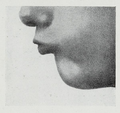| Mentalis | |
|---|---|
 Muscles of the head, face, and neck. | |
| Details | |
| Origin | Anterior mandible |
| Insertion | Chin |
| Nerve | Mandibular branch of facial nerve |
| Actions | Elevates and wrinkles skin of chin, protrudes lower lip |
| Identifiers | |
| Latin | musculus mentalis |
| TA98 | A04.1.03.037 |
| TA2 | 2087 |
| FMA | 46825 |
| Anatomical terms of muscle | |
The mentalis muscle is a paired central muscle of the lower lip, situated at the tip of the chin. [1] It originates from the mentum of the mandible, and inserts into the soft tissue of the chin. It is sometimes referred to as the "pouting muscle" (as in duck face) due to it raising the lower lip and causing chin wrinkles.


